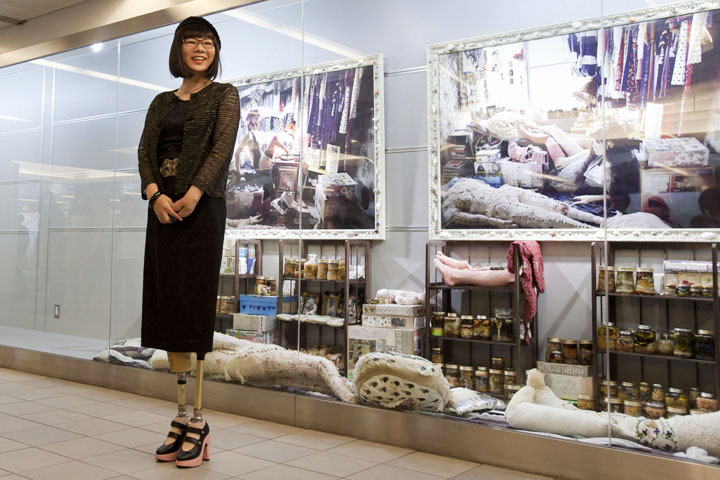
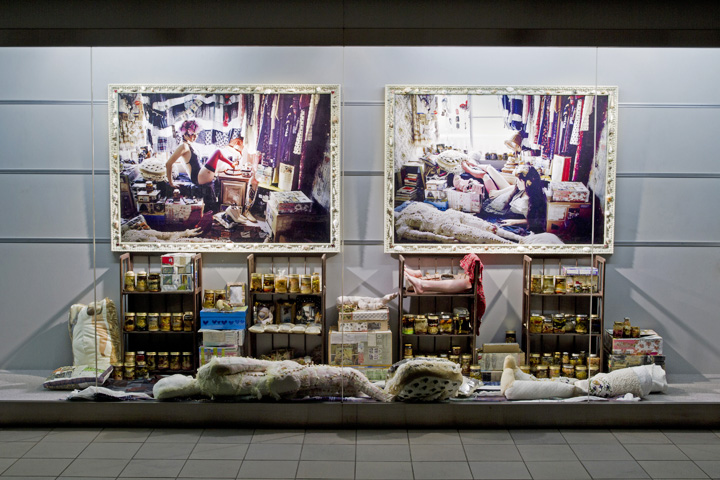
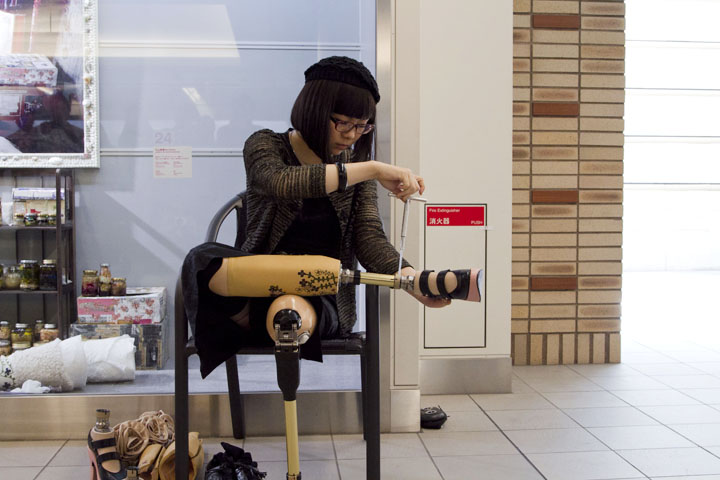
Interviewer: Taro Amano (Chief Curator Yokohama Museum of Art)
Interview date: 2013.2.16
Not selling the work
Amano: I saw Katayama-san's work at last year's Art Award Tokyo Marunouchi (AATM) final screening and I'm sure I thought the work itself was interesting, but at that time Katayama-san said, ``I don't want to sell my work.'' I was concerned about what you said. Normally, we think of Artist as creating things and selling them to become professional artists, but I don't think that's the case with Katayama at least. I wanted to hear the reason for this in depth. Mr. Katayama, when did you first start thinking of yourself as Artist?
Katayama: The first opportunity was to apply to the Gunma Youth Biennale in my hometown, as my high school teacher encouraged me to do so, saying, ``If you apply, we'll treat it as if you submitted an assignment.'' Although I had never created a work of art, I created and presented a wooden panel decorated with a prosthetic leg attached to the theme of my own prosthetic leg, and received the Encouragement Award. At the award ceremony, I met independent curator Takashi Higashiya *1, who was a judge, and that was what really got me started.
Amano: That's right. What time was it?
Katayama: I was 16 years old, about 8 years ago. At that time, Higashitani-san told me, ``If you make something else, please let me know.'' Since then, every time I've made something, I've packed it into my backpack and gone to Tokyo to have Higashitani-san look at it. I would show my work and return to Gunma again every six months, and in 2010 I participated in a group exhibition at NCA|Nichido Contemporary Art organized by Mr. Higashitani. It was also the first time I exhibited in a white cube. So it's only in the past two or three years that I've started to think about exhibiting my work.
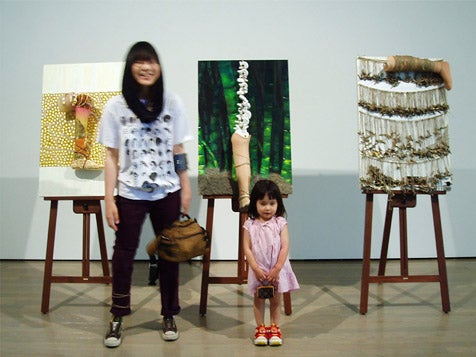 Gunma Youth Biennale, 2005
Gunma Youth Biennale, 2005
Amano: Before last year's screening, I happened to meet another artist who doesn't sell his work, and when I was thinking hard about what it means to make something but not sell it, Katayama-san said the same thing to me. is not it. May I ask you about that?
Katayama: Yesterday, while I was making the box I exhibited at AATM, I was thinking about why I was making it. The box is made from a collage of courier boxes, and I use it as a box to put things that are important to me. The things you make are always something to display in your room, in other words, to improve your living space. The viewer sees the entire installation, but I love the jars, the patchwork figures, and the cotton stuffed inside, so I don't want to give them away or exchange them for money.
Amano: But you're going to put it on display and show it off. What does it mean for you to show something?
Katayama: I've been making music for a long time, so I think that has something to do with not selling it. I used to get paid to sing and express myself using my body, so I like singing as a performance and inviting people to my house to watch. I feel like there are two ways to show it.
Amano: Music is said to be "the art of time," and singing is not an object, but a voice. You pay the admission fee, share your time, and the voice itself disappears. Does that mean that the sense of unity that comes from working with your own body and the work you create is consistent with that of music?
Katayama: Previously, we used to completely separate songs from songs and works from works. However, as I started making videos and started directing live performances, and started doing performances where I walk in high heels with prosthetic legs, it became difficult to clearly distinguish between the two. The other day, I was walking around Shinjuku wearing high heels, and my body really stood out, so I started thinking that if I could convey something through it, I could use it as an expression.
Amano: That means exposing yourself. Moreover, there are many regulations on the road. If it's an art museum, what happens there is clearly based on the conventions of art, so basically everyone can view it with peace of mind. But you never know what's going to happen on the street. Is there a reason you choose a public place?
Katayama: For me, creating is a part of my life and a very normal thing. Similarly, if you think about it, it's normal for women to walk around town wearing high heels. But when I wear high heels, I stand out because I'm almost 2 meters tall, so it conveys a message. That's why creating things at home and walking around town, both of which are normal things for me, become unintentional expressions. I feel like I'm lucky in that respect.
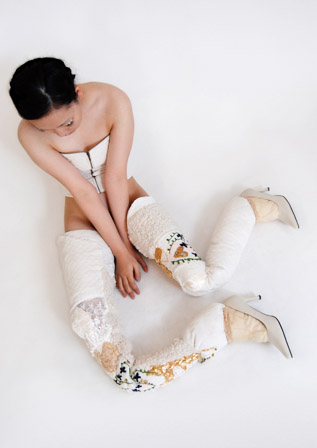 "white legs", 2009
"white legs", 2009
Amano: I think there are people who can't help but work hard to create things. My mother is a dressmaker, and she made all of my clothes and bags when I was a child. But she didn't think of it as an expression at all, nor did she think anything would happen by putting it on a child. I wonder what the difference is. Mr. Katayama also worked hard to make his room comfortable, and if he could, he would like to invite people over to see it, and even more so, he would like to do something on the street. However, what is the difference between exposing oneself to an unspecified number of people and showing one's work as an object? Furthermore, if someone likes it and wants to get it, they say, ``You're not going to sell it.'' Expression is ultimately a desire, and everyone wants to cause some kind of incident through expression, but most people would like to make it their profession and make a living from it, but in Katayama's case, he was just short of that. It bends tightly (lol). That's what I still don't understand.
Katayama: Actually, my mother also made all of my clothes. I lived in a house where the sound of a sewing machine was constantly making noise, and as far back as I can remember, I used to sew with a needle before a pencil. My feet were curved due to a calf bone defect, so I wore corset-like orthotic shoes to correct them, but they were stiff and heavy and I couldn't wear children's clothes, so my mother made them all. There were also circumstances. However, she didn't make it her job. Because I grew up in that kind of environment, I never really thought about selling what I made to make money, and I didn't make it with the intention of making a living as Artist. In fact, I think that making clothes and decorating feet is a kind of Fashion. However, I wanted to wear high heels but couldn't do so with a prosthetic leg, so I made a pair of feet that looked like stuffed animals and had them wear them, and I patchworked them into the shape of the legs that had been amputated and stuffed them with clothes so that they weighed the same weight as the legs. However, they do not stand upright, and are not intended to function as legs in the first place. I myself wonder why we create things that don't work. There are many things that you learn while creating. AATM was the place where we exhibited what we have been creating for so long.
Amano: Did you have surgery and cut off your leg?
Katayama: Yes. The human foot is made up of thick and thin bones called the tibia and fibula, but in my case, I only have the fibula and no thick bones, so my foot warps under the weight of my body. When I was little, I corrected myself with a corset. But as I grew older, my body became too big to support myself, so I had my leg amputated when I was 9 years old. Since then, I have been living with a prosthetic leg for 15 to 6 years.
Amano: Without fear of misunderstanding, the fact that he lost his leg through amputation means that he probably could have chosen not to have it amputated. There is a story about how when you wake up in the morning, you feel like you don't have any legs but only the itch remains, but perhaps Mr. Katayama has a feeling that he doesn't want to lose what was lost, or what he was involved with. I wonder if there is. Maybe I'm overthinking that.
Katayama: There are many. However, it is different from the word "feeling of loss." In fact, in exchange, I am now able to walk with prosthetic legs, drive, and even stand on stage and sing. So I don't have any negative factors like ``to make up for something'' or anything like that, but my feet still hurt sometimes. The soles of my fingers hurt, but I tell myself it's just a hallucination because I don't have legs. I think that's what I want to do when I'm making a foot object, thinking, ``Ah, that's where it hurt.'' I think the reason why you don't want to give something to someone else, no matter how understanding they are, is because you feel like you're the only one who can make use of it.
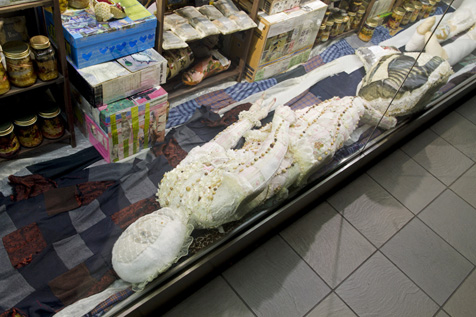 a.a.t.m. 2012
a.a.t.m. 2012
Art that escapes the freedom of ownership
Amano: I've been working in art museums for a long time, and there are still art museums that have rules for art, and anything that doesn't meet those rules is not allowed. We are currently holding an exhibition on press photographers called ``Robert Capa and Gerda Taro: Two Photographers,'' but from a museum perspective, press photography is not art. But the reason why I display it as a work of art is because there are people who want to see it. We live in a time when people have strong desires, and it doesn't matter if it's a news photo or art, they want to see it, want it, and buy it. If Mr. Katayama's work continues in its current form, museums probably won't be able to afford it, and they won't be able to buy it. I don't mind that, but can I continue like this forever?
Katayama: I don't want to give physical works away, but photographic works are OK.
Amano: Who is taking the photos?
Katayama: It's all me. I have bad eyesight, so it's very difficult for me to decide on a pose and then move, so I've had people take pictures for me, but it just doesn't feel right. That's why I choose to shoot everything I present by myself in a room by myself.
Amano: Is it okay to sell photos because even if you take the photos yourself, there are people involved in developing and enlarging them?
Katayama: That's right. That's why the two-piece photo set I exhibited at ATM won't sell because I made the frames myself. Some of them wanted the prosthetic leg I was wearing. Isn't it good because I didn't make it myself? That's it. But I think that kind of logic is strange, and there is a line to be drawn.
Amano: In the series `` All by myself'' by a photographer named Nan Goldin *2, there is a slide of a woman whose face is swollen after being punched in the face by her partner due to domestic violence. There was a collector who really wanted it, so I asked him one day, and he told me that he would not sell it to a private collector, and that he had no intention of selling it to anything other than a public museum. That was the first time I met an artist who said, ``I'll sell here, but not here.'' Goldin also publishes photo books, which anyone can buy, but he doesn't want slides. I sometimes thought that the slide itself was like a part of my body.
On the other hand, when I asked an author whose work dealt with the genocide in Rwanda, Africa, if he would sell it, although people who like genocide might buy it, he said he would sell it. I can't control it that much, so I have no choice. In other words, since the 19th century and into the modern era, works of art have become products.
Up until then, there were patrons who would ask Artist to make works for them. The relationship between Artist and the person ordering must have been close and personal. However, in the 20th century, anyone could buy it. It gave me the freedom to own it. However, just as we have gained the freedom of ownership, we don't know who will end up with the artwork, and we can't put any restrictions on that. Even if you want the person who understands you the most to have it, you have to wish it in your heart. Expression is free, and as long as you have money, you can buy anything, and even human organs can be bought and sold. I think it's very true, and I want it to continue to exist. Even if I say that, about 10 years from now Mr. Katayama might say, ``I told Mr. Amano that at the time, but lately he's been selling quite a lot.''
Katayama: I don't think so (lol).
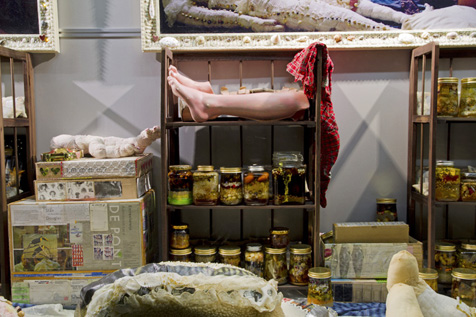 a.a.t.m. 2012
a.a.t.m. 2012
Amano: In modern times, artists create works for themselves, and the value of art is determined by how well it sells. Of course, it may be valued posthumously, but either way, its value has been determined by how well it sells. Even in museums, people think about purchasing an item once it has been priced properly and is recognized by the public. However, it has only been about 180 years in the history of art, which spans more than a thousand years, that works have been commercialized. I think that the value of art is determined based on what it has done for just 180 years, but that's not all.
I think that art is a history that we continue to create, perhaps feeling the frustration of not being able to control everything ourselves. The better you are as an artist, the more genuine your frustration becomes.There is something you've lost, whether it's your body or your mind, and no matter how hard you try, it's hard to make up for it, but you keep going. The viewer feels a sense of reality when they see him struggling with frustration. I think there are many things about Mr. Katayama's behavior that we, who are not the creators, but also the viewers, need to consider. After all, if all you hear is things like, ``It's amazing that that work sold for 10 million yen. Now you're finally on the top of your game,'' there's no room for you to think about it any further.
Katayama: Lately, I've been thinking a lot about what Mr. Higashitani has done for me. When I brought my work to him, Mr. Higashitani never told me if I should do it this way or that, he just looked at it and said, ``Yeah, yeah, show it to me again.'' And yet, ever since we first met in high school, people always told me, ``You're an Artist.'' Now that I think about it, I think that people like me who can't stop creating are the ones who taught me that art is the easiest world to live in.
Amano: It might be some kind of salvation for Mr. Katayama to continue doing what he did in silence, and I guess he really thought it was a good idea to continue doing it. I guess he knew how pointless it was to say, ``I should make something like this.''
Katayama: He wasn't the one who paved the way for me, but he was the one who watched over me to make sure I didn't run in the wrong direction. When I was approached about exhibiting at NCA, I initially declined because my grandfather, who had raised me, had just passed away, and I felt mentally unable to hold an exhibition. But he said, ``Don't worry, come here.'' It was my first time hearing the word white cube, and I didn't know how to show it to others, but I said, ``Leave that to me and do whatever you want, just like you always decorate your room.'' He encouraged me. There is no one who understands my work better than him, and I'm really glad that I met someone like him. Even when I was at ATM, I called him and said, ``I won the Grand Prix!'' and he was surprised and happy, saying, ``Eh, why?''
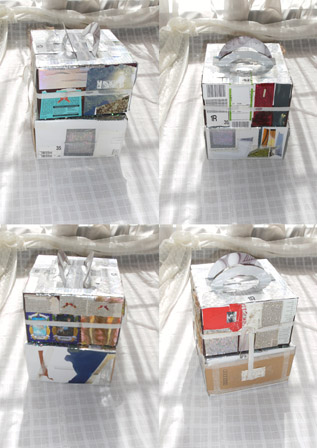 "boxes", 2005-2013
"boxes", 2005-2013
The power to keep creating will save you
Amano: When you get to my age, there are quite a lot of Artist you've met, but there are only a limited number of artists who you feel are still as good as when you met them a long time ago. Writers have their own circumstances, so it can't be helped, but just seeing people who persevere in this way makes me feel good. It's like a mirror looking back at yourself.
There is an Okinawan photographer named Mao Ishikawa *3. I'm an old lady who only takes pictures of Okinawa, but this one feels nice and doesn't shake. She was photographing events at a black-only bar in the U.S. military where she worked when she was young. But my colleagues told me not to display it, so I threw away all the negatives. However, when Mr. Ishikawa found out that his late father had secretly kept the prints, he cried and declared that no matter what happened, he would display them no matter what, and that if the people in the photos came, he would talk to them. By the way, there's an exhibition going on right now, and I'm going to Venue every day.
In the past, it was believed that the truth could only be pursued with objectivity; for example, there was a time when it was believed that the truth could only be pursued when researching minorities was done objectively by a third party who was not a minority. Ta. However, we are now in an era where those involved are doing research on those involved. There is a shift towards things that only those involved can understand, and I think that's a really good story. A party talks about a party — Mao Ishikawa is a party in Okinawa. That's not to say I'm whining. I think that's the interesting part.
Katayama: When I heard about Mao-san's father, I was reminded of the work ``Peace,'' which was also shown at ATM, in which empty Peace cigarette boxes were wrapped in dried yellow roses and stuffed one by one. Peace was my grandfather's favorite cigarette, and when I was about 16 years old, I asked my grandfather, just as Artist, to keep that Peace box because it was so cute. Many years later, when I was sorting through my grandfather's belongings, I found nearly 2,000 empty cardboard boxes of Peace in the closet. It was then that I realized for the first time that my grandpa had remembered it forever. I'm still making them, but I still can't catch up to 2,000 pieces.

"yellow coffin", 2010
Amano: I really took the words of my high school grandson to heart.
Katayama: When I saw the items lined up in cardboard boxes so neatly that I thought they were brand new, I knew I had to make them. Up until now, I had been using materials freely, but for about six months after entering graduate school, I was really worried about what I should do with this. But when people say they want these, they say they want 10 or they want a dozen. I explain that this is the reason why it doesn't sell.
Amano: The writer Louise Bourgeois *4, who lived to be nearly 100 years old, was a writer who suffered from the deep trauma she received from her parents as a child, struggled and struggled, and continued to search for salvation through creation. He held his first solo exhibition at the Museum of Modern Art in New York at the age of 71, and was already 84 years old when I asked him to do an exhibition. Taking the house that she hated as her theme, she continued to create unstable houses and sculptures throughout her life, while also working as a housewife and mother. When I went to my house, I saw a stuffed animal-like object tied up and hanging from the ceiling. However, even though he was over 80 years old, Bourgeois said that he couldn't understand how much it helped that he had someone who told him it was OK to create something like this. The art books at that exhibition were sold out, and girls in particular bought them. You'll understand when you see the exhibition.
In that sense, I think there is a responsibility to announce it publicly. Expressing something can save the person expressing it, but it may also save others. The images and works of people who express themselves in this way may help people.
The reason I asked you today, ``Why don't you sell it?'' is probably because I don't want to let myself down. There are definitely people who will be helped by seeing your work, so I hope that Mr. Katayama will continue to do his best without wavering.
Born in 1968. Contemporary art curator. After working at Setagaya Art Museum, Mori Art Museum, etc., he worked as a freelancer. Exhibitions of contemporary art that remain in people's memories, such as "Temperature of the Age ART/DOMESTIC" (1999), "GUNDAM For the Future" (2005-2007), and "Busan Biennale 2010 Living in Evolution" (2010). I managed the meeting. He has demonstrated a wide range of talents not only as a curator, but also as a writer, musician, Artist, and performer. Died in 2012.
*2: Nan Goldin
Born in Washington DC (USA) in 1953. photographer. He became known for a series of autobiographical photographs of the daily lives of his friends, including drag queens, drug addicts, and sexual perverts. He has held exhibitions around the world including Boston, New York, Paris, and Barcelona, and has exhibited in Japan at the Museum of Contemporary Photography, Tokyo (1991), collaboration with Nobuyoshi Araki (1994), and "Tokyo Love" at Shiseido Art Space (1994). has been done. His photo books include The Ballad of Sexual Dependency, The Other Side, and I'll be Your Mirror.
*3: Mao Ishikawa
Born in Okinawa in 1953. A photographer who consistently takes pictures of Okinawa and the people associated with it. In 2011, won the Sagamihara Photography Award for “FENCES, OKINAWA”. His major works include ``The Eyes That See the Rising Sun'' (Miraisha, 2011) and ``Okinawa Soul'' (Ota Publishing, 2002).Major exhibitions include the solo exhibition ``Photographer Mao Ishikawa - Photographing Okinawa'' (Yokohama) Her works include Citizen Gallery Azamino, 2013) and ``Connecting Asia: Women Living on Borders 1984-2012'' (toured to Fukuoka Asian Art Museum and other places, 2012-2013). Scheduled to be exhibited at Mori Art Museum's 10th anniversary exhibition "LOVE: Shapes of love seen in art" (April 26 - September 1, 2013).
*4: Louise Bourgeois
Born in Paris in 1911. Sculptor. Due to her complicated family environment, where her father's mistress was her private tutor, she turned to the art world to create art in order to heal from the trauma of her own childhood. She has created many dynamic works that are tinged with unique pain, such as Maman, a giant spider statue that symbolizes her mother, and a series of her childhood rooms. In 1982, at the age of 71, he held a solo exhibition at the Museum of Modern Art in New York. Solo exhibition at Yokohama Museum of Art in 1997. Winner of the Golden Lion at the Venice Biennale in 1999. In 2008, at the age of 96, a major retrospective exhibition was held at the Center Pompidou in Paris. Died in 2010.
Mari Katayama
Born in 1987. Both legs were amputated when he was 9 years old. Since then, he has created self-portraits using prosthetic legs that he has decorated himself. Currently, in addition to creating works, she is active in a wide range of activities including music, modeling, and lecturing. Received the ``Gunma Youth Biennale '05 Encouragement Award.'' (Gunma Museum of Modern Art, 2005), major exhibitions include "identity, body it. - curated by Takashi Azumaya" (nca, 2010) and "About Freedom 2 Glasses + Mari Katayama" (TRAUMARIS SPACE, 2012). be.
Taro Amano
Since 1987, he has been involved in planning numerous exhibitions both domestically and internationally at Yokohama Museum of Art. Belongs to the Art Critics Union. Major exhibitions include "Yasumasa Morimura Exhibition: Diseases that Lead to Beauty" (1996), "Yoshitomo Nara" Exhibition (2001), and "Contemporary Photography I, II, III" (1996, 2000, 2004). ), ``Idol!'' (2006), and many others. Curator of Yokohama Triennale 2005, Curatorial Team Head of Yokohama Triennale 2011 and 2014. Chief curator Yokohama Museum of Art. Part-time lecturer at Tama Art University, Kokushikan University, and Josai International University.

